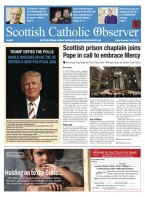November 4 | ![]() 0 COMMENTS
0 COMMENTS ![]() print
print
Let’s find a place for art to touch the soul
THE BOW IN THE HEAVENS this week considers profound creative responses to the mystery of the cross and to martyrdom at the hands of Isis - By Fr John Bollan
I MENTIONED last week that the parish was looking forward to a rare ‘double-dunter’ in the Institution of an Acolyte and the blessing of a set of icons for the sanctuary of St Joseph’s.
Well, I say ‘looking forward,’ but beneath a façade of what looks like confidence, I am quite the worrier. Unhelpfully, I tend to do most of my worrying during the night and the approach of this red-letter day (along with a number of other impending jobs) led to a fair few nights of nocturnal clock-watching.
On this front, at least, I need not have lost any sleep. The whole evening was really lovely and everything went so well: the liturgy itself was dignified and solemn but allowed for moments of lightness too. Bishop John Keenan offered an excellent reflection on the ministry upon which our faithful parishioner was entering and the spiritual and artistic meaning of the icons. There is a feature on the occasion elsewhere in this edition (in fact, this week it’s a bit of a Bow Road takeover!) but I would like to say a little about how the new icons came to be.
St Joseph’s is a post-war parish with a post-war church. Its design and the materials used to build it reflect the slender means at the disposal of the people who moved into this area in those days of rationing and austerity. That said, thanks to my predecessors, it has always been a church which has tried to reflect something of the sacred art of its time. This was particularly true of Ferdinand Canon Tritschler, parish priest from 1959 to 1975. In the mid-1960s his brothers, Cornelius and Francis, made the statue of John Duns Scots in his birthplace of Duns in the Borders and it is still a celebrated landmark in those parts.
These same brothers were responsible for the mosaics and the ‘old’ crucifix here in the sanctuary of St Joe’s. The Tristchler crucifix, in fibreglass, certainly captures the brutal ordeal of Our Lord’s suffering on Golgotha: it is an invitation to contemplate the Lord’s suffering—and he looks you in the eye for good measure. Yet, upon assuming the mantle of parish priest, I found it odd that a Church under the patronage of the carpenter of Nazareth should have nothing of wood in the sanctuary.
And so came about the idea of replacing the ‘old’ crucifix with a new triptych of icons. I had liked and admired the icon of Our Lady of Paisley painted by Coatbridge artist Bernadette Reilly. Bernadette was already a friend of Bishop Keenan (back in his pre-episcopal days) and he enthusiastically endorsed the idea of approaching her with the commission to paint the new crucifix in the same distinctive ‘neo-Coptic’ style as the Paisley icon. This undertaking was not without a measure of risk, however: tampering with sacred fixtures is a risky business. People can sometimes be very tetchy about anything which changes the complexion of a building they have had longer associations with than some ‘Johnny-come-lately’ parish priest. I find, however, that if you are honest and sympathetic, you can usually win people round. In truth, though, not much persuasion was necessary.
The style of the icon was also something of a leap of faith. I love neo-Coptic iconography, which has its roots both in Egyptian and Orthodox Christianity, but I did worry (naturally) that it would not be ‘Catholic enough’ for some tastes. Although icons are increasingly present in our churches, there is no denying that they have only recently begun to impinge upon our spiritual consciousness here in the West. But then, in February of last year, an act of barbarism by the so-called ‘Islamic State’ sealed the deal for me.
‘Isis’ had beheaded 21 Coptic Christians, recording the gruesome spectacle for their own twisted propaganda purposes. I chose not to watch the film of their murders, although those who did pointed out that many of those who perished did so with the name of Jesus on their lips. Fittingly, the most enduring image of this outrage would not be that death cult’s ‘snuff movie’ but an icon, in the neo-Coptic style, of these men as martyrs for Christ. That was all the validation I needed: the new icons would be both an expression of love and an act of defiant solidarity with fellow Christians in their martyred lands.
What has been produced is a beautiful focus for our eyes and hearts during the holy sacrifice of the Mass. The face of Jesus is peaceful and his outstretched arms draw you into an embrace. On either side, the Blessed Mother and the Beloved Disciple are not mere ‘book ends’ but participants in this drama of redemption. The mystery of the cross is still being played out. As those martyrs—or ‘witnesses’ on the shores of Libya so eloquently demonstrated—fresh icons of the Passion are being written every day, even in our midst.
As I have said to the artist more than once: every time I look at our crucifix, I love it more and more. This is not just a superficial aesthetic appreciation of a work of art, but a living image which touches the soul. Maybe it’s not so much that I love the icon more and more, but that I am becoming ever more aware that it—or rather the one it depicts so beautifully—loves me.











